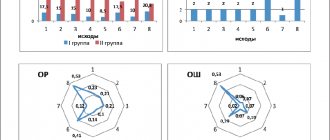Is an allergy to cow's milk treated in a child, what to give to a bottle-fed allergic baby and what should a mother do if her breast milk causes an allergic reaction in the child - these and other popular questions from mothers are answered by Doctor of Medical Sciences, Professor of the Department of Pediatrics with a course Polyclinic Pediatrics named after. Academician G.N. Speransky Federal State Budgetary Educational Institution of Further Professional Education RMANPO of the Ministry of Health of Russia Irina Nikolaevna Kholodova.
— Irina Nikolaevna, how can you understand that a newborn or a 1.5-2 year old child has an allergy?
— I would like to draw the attention of parents to the fact that if there are people in the family who suffer from allergies, then, of course, the likelihood of allergies in the child will be quite high. For example, if only the mother suffers from it and all allergy sufferers are on the mother’s side, then the probability of an allergy is 40-50%, and if on both the mother’s and father’s side, then it is already 80%. That is, allergies are inherited
and in a child it can manifest itself from the first days of life. In young children, skin and gastrointestinal forms of allergies are most common.
Skin allergy
In young children, it is the cutaneous form that predominates (previously it was called exudative-catarrhal diathesis, now it is called atopic dermatitis) - an allergic rash appears on the child’s body. This can be a dry or wet rash, most often with itching.
Gastrointestinal form of allergy
This form is more difficult to diagnose, and it can be very difficult to understand that it is an allergy. Such children may experience severe colic from the first days of life - food is poorly digested, under-oxidized products are formed that irritate the gastrointestinal mucosa and can cause inflammation. In addition, due to impaired fermentation of food, a large amount of gases is formed. Gases stretch the intestines and put pressure on nerves and blood vessels. All this causes spasm and pain.
Subsequently, changes in the character of the stool may appear - there are constipation, but most often diarrhea occurs. Moreover, stool is usually several times a day, and it can be irritating, with a lot of mucus and even streaks of blood. The child begins to eat poorly, there is poor weight gain, and subsequently there may be a slowdown in growth. In such a situation, it is necessary to hospitalize the child to determine the cause - it can be not only an allergy, but also other diseases.
Is milk not for everyone?
The main task of the immune system is to recognize “self” and “foreign” cells. It reacts mainly to substances of protein nature, forming either a “Friend” (so-called immunological tolerance) or “Enemy” (antigen) response. When the response is “Enemy,” specific substances (antibodies) are produced that are aimed at fighting it. But, as with any system, there are failures.
Allergy (atopy) is an example of one such failure, when even friends are blacklisted. The child’s immune system begins to react to BCM inappropriately and excessively, blacklisting it. Beneficial protein turns into an allergen. This reaction is called "hypersensitivity."
The reasons for the occurrence of such “problems” are not reliably known to anyone. Scientists only build hypotheses, accumulate and systematize knowledge. All experts agree that genetic predisposition plays an important role. The only way to break the vicious circle of allergies and help a person is to exclude the causally significant allergen from the diet (environment) of this person.
This is called elimination (and elimination measures).
Milk substitutes in the diet
In recent years, soybean has been considered one of the substitutes for cow's milk, mainly soy milk and soy-based products.
It includes, among others, vitamin E and B, calcium, protein, magnesium, iron, phosphorus and lecithin. However, soy is not always safe. Soy products are not recommended for children under 6 months of age. Moreover, in severe allergies, the intestinal mucosa may be receptive to soy protein, resulting in soy allergy. You can also use coconut, rice or nut milk. Excluding cow's milk, you need to take care of the right amount of calcium in your diet. Its sources: eggs, fish (which contain bones, for example, sardines, sprats), as well as plant products: bread, flour, coarse cereals, dried legume seeds, vegetables (for example, spinach, chard, cabbage), nuts, cocoa, figs and dried apricots. Also allowed: meat, cereals, bread and eggs. Of course, fruits are also highly recommended, but you should be careful with citrus fruits. The menu can be based on these products; you can additionally maintain calcium levels, for example, using tablets.
Forbidden sweets, that is, sweets containing milk, can be replaced with dairy-free analogues, for example, milk chocolate can be replaced with dark chocolate or dried fruit candies, and a purchased cake can be prepared independently by baking it without adding milk.
Atopic diseases. How to suspect them?
Often people don’t even know about the diagnoses listed above because they don’t see a doctor.
The following symptoms should alert you:
- seasonal nasal congestion or runny nose with copious mucus production
- occasional lacrimation
- bouts of coughing and sneezing
- prolonged dry cough
- bouts of difficulty breathing
- wheezing
- rashes, redness and itching of the skin
- skin prone to dryness and flaking (periods or after contact with something)
- redness and/or other skin reaction to sun or cold exposure
- skin irritation after contact with something
- reactions to insect bites
- reactions to drugs
If the above symptoms occur, then there is a high probability of atopy. In this case, it is better to seek advice from a specialist. If you have allergies, be sure to tell your pediatrician about it and monitor your child’s diet.
Symptoms of a milk allergy
Cow's milk contains more than 25 different proteins, each of which can cause allergies.
The most common and most important allergen, causing cow's milk allergy in 80% of patients, is β-lactoglobulin, that is, whey protein. A cow's milk allergy can usually be diagnosed in the first weeks of a child's life. It manifests itself mainly as ailments of the digestive system. In infants this is usually: • lack of appetite;
• vomit; • abdominal colic; • diarrhea.
As a result, this often leads to weight loss.
Another symptom of this allergy is skin changes, such as: • roughness of the epidermis; • itchy spots (especially under the knees, arms and elbows); • redness of the cheeks; • Older children also develop atopic dermatitis.
An allergy to cow's milk can also be caused by: •
dry cough; • chronic runny nose; • laryngeal and/or bronchial shortness of breath (inflammation); • frequent, recurring otitis media.
However, these symptoms may be caused by another disease, such as lactose (milk sugar) intolerance. In this case, lactose-free Zeta is recommended. Food allergies often affect multiple organs. Its clinical symptoms include: • skin (atopic dermatitis - eczema, urticaria, angioedema); • respiratory system (chronic rhinitis, cough, laryngeal edema, recurrent pneumonia, bronchial asthma); • digestive system (diarrhea, vomiting, swelling and itching of the lips and oral mucosa, infantile colic, intestinal villous atrophy, colitis, esophagitis); • cardiovascular system (decreased protein concentration in blood plasma, anemia, increased number of eosinophils). In children under one year of age, gastrointestinal symptoms predominate. Their peak intensity occurs in the first six months of life. Skin symptoms usually appear at the end of the first year of life.
Is it possible to prevent the development of ABCM?
Yes.
During pregnancy, the process of “friend/foe” recognition begins. The future mother’s nutrition plays a significant role in this. Products containing choline, methionine, zinc, folic acid, vitamins B6 and B12 can regulate gene function and contribute to the formation of tolerance (body resistance) to CMP.
During breastfeeding, you can limit the consumption of dairy products and other obligate allergens. This will reduce the burden on the child’s body and will also contribute to the formation of an adequate response of the immune system to BCM.
Obligate allergens are foods that often cause allergic reactions: eggs, fish, seafood, legumes: peas, beans, soy, peanuts; nuts, honey, strawberries, pomegranate, kiwi, melon, black currant, mushrooms.
What substances cause allergies?
Food allergens are any substances, most often of a protein nature, that stimulate the production of immunoglobulin E (IgE) or the cellular immune response.
The products that most often cause allergic reactions are grouped by experts into the “Big Eight”. It includes: cow's milk, chicken eggs, soy, peanuts, tree nuts, wheat, seafood and fish.
Cow's milk protein
(BKM) is the main allergen. Most often, true allergy to cow's milk occurs in the first year of life and accounts for 2–3% among infants. But over the years, the child develops tolerance to this protein (that is, tolerance, resistance): by the age of 5, approximately 80% of children do, and by the age of 6, the incidence drops to less than 1%.
It must be remembered that the milk of other mammals, including goats, also has allergenic properties. It can either cause cross-allergic reactions in patients with allergies to CMP, or be an independent allergen.
Of course, allergy to CMP occurs more often in bottle-fed children. Too much foreign protein comes from the formula. Due to the immaturity of the intestinal barrier and as a result of the immune response, infants develop early sensitization (hypersensitivity) to cow's milk protein. But breastfed children may also develop an allergy to CMP due to the penetration of food proteins into breast milk.
In a chicken egg
13 protein allergens are determined. Children with an allergy to chicken egg whites develop tolerance in 4% of cases by age 4, and in 12% by age 6.
Soy can often be the cause of allergic reactions.
or products with soy protein.
Quite often, allergies are caused by cereal products.
, primarily wheat gliadin, gluten of rye, barley and oats, less often - proteins of corn, rice, buckwheat. Usually the first signs appear during the introduction of complementary foods, when the child is “introduced” to cereals.
In fish and seafood
There is a protein that is practically not destroyed during cooking. It is found in many types of fish. Allergies to fish usually do not go away with age, persisting in adolescents and adults.
Allergens from fish and seafood can cause severe systemic reactions when even a very small amount of the allergen enters the body.
Peanut
, like peas, beans and soybeans, belongs to the legume family. Peanut proteins contain a lot of allergens. Peanuts are widely used in the food industry, so it is worth remembering that they often become a “hidden allergen”.
Different foods can cause cross allergic reactions due to the presence of proteins that are similar in structure. More than 90% of children with an allergy to cow's milk protein develop cross-allergic reactions to goat and sheep milk.
If supplementary feeding is needed?
In the first three months, all children, regardless of the degree of risk of developing CM, are recommended to use only mixtures with specially prepared protein. Their degree of allergenicity is significantly reduced, which is why they are called hypoallergenic. The NutrilakPremium Hypoallergenic mixture is additionally enriched with probiotics and food substrate for their growth and development (prebiotics). The NutrilakPremium Hypoallergenic fat component in combination with lutein best provides all the needs for the development of the child’s brain, vision and motor skills.
How does an allergy to BCM manifest in a baby?
Symptoms of ABCM can be very different.
With skin lesions:
- the appearance of dry skin, sometimes in the form of plaques
- redness of certain areas of the skin (around the mouth, arms and legs, cheeks, chest and abdomen)
- the appearance of weeping spots and crusts with severe itching
- long lasting diaper rash
Involving the gastrointestinal tract:
- private regurgitation
- colic
- constipation
- diarrhea
- mucus in stool
- blood-streaked stool
- poor appetite and slow weight gain
The mucous membranes of the eyes, nose and respiratory tract may be involved with the following symptoms:
- lacrimation
- prolonged runny nose
- distant wheezes
- paroxysmal cough
All this can also affect the baby’s behavior in the form of:
- irritability
- sleep disorder
- bouts of crying and anxiety
It is important!
If symptoms persist after eliminating the causative allergen from the diet, it may not be a food allergy.
Contact your pediatrician immediately. In this case, a nursing woman needs to return to a balanced diet that includes all foods acceptable in the diet of nursing women (to prevent nutritional deficiencies in both her and the child).
If the baby is on mixed or artificial feeding, then together with the pediatrician it is necessary to decide on the correct selection of nutrition for him.
If the baby is already familiar with complementary feeding products, then together with the doctor, review the menu again. Make changes if necessary. Products containing BCM should be excluded. Keeping a food diary for mother and baby will greatly facilitate the process of finding the allergen and taking measures to eliminate it.
Causes of food allergies in newborns
Food allergies in babies who have just been born are very rare. The baby receives only mother's milk. This is food that nature created for your baby and nothing can be better than it. Therefore, the peak age of food allergies in breastfed infants can be considered around 4–5 months, when the baby begins to receive complementary foods - products added to breast milk: vegetables, fruits, cereals, meat, dairy products and others. The situation is somewhat different with bottle-fed babies. The formula itself can cause food intolerances. Therefore, when choosing a mixture, it is better to consult a specialist.
How to confirm the diagnosis of ABCM?
There are not many tests in a doctor's arsenal for this, and there are no gold standards. There is no analysis that can confirm the diagnosis with 100% certainty.
The immunological tests performed can be divided into:
- nonspecific, confirming the allergic nature of inflammation
- specific, indicating the degree of significance of the influence of a particular allergen
Difficulties in diagnosing ACM It is extremely rare that only one allergen (CAM) is the cause, the trigger that triggers inflammation
- Most often these are several allergens at once (polyvalent allergy)
- There is cross-reaction between different groups of products
- If the child is breastfed, immunological tests are difficult to interpret (due to the presence of maternal antibodies in his blood)
Diagnostics
To make a correct diagnosis, in addition to collecting a medical history and examining the child, the doctor will prescribe a number of laboratory tests and clinical tests. The latter are especially important, even with obvious signs of lactose intolerance in children.
- Complete blood count – moderate increase in leukocytes. The erythrocyte sedimentation rate is also increased.
- General urine analysis - increased protein and the presence of casts with half-destroyed eosinophils.
- Blood biochemistry – increased number of immune complexes, increased protein.
- Immunogram – predominance of class E immunoglobulins (antibodies).
- Identification of lymphocytes and antibodies sensitized to milk proteins is one of the main tests, the accuracy of which is more than 92%.
In addition, skin prick tests are recommended to clarify the diagnosis. The latter, by the way, will help answer the question “can a child be allergic to goat’s milk?”
Our website provides a complete list of diagnostic procedures that are carried out in the clinic. After laboratory tests, you can consult an allergist who will answer all your questions and tell you what you can feed your baby after a year if he is allergic to milk.
Ways to select nutrition for ABCM
It all depends on the severity of the allergic process, existing symptoms, the age of the child and the type of feeding.
Breastfed
It is enough to organize the mother's nutrition.
With mixed feeding
If supplementary feeding is necessary, experts recommend using a mixture with split protein hydrolyzate. Of these, you can consider the Nutrilak Premium Hypoallergenic mixture.
Compared to whole molecules of cow's milk proteins, the allergenicity of its split protein is reduced by 100,000 times. Nutrilak Premium Hypoallergenic is suitable for the prevention of allergies in children at risk and the treatment of mild skin manifestations.
What is the most common allergen in infants?
1. The first place is occupied by intolerance to cow's milk protein. It should be noted that most modern formulas for feeding infants are based on cow's milk proteins. This is the reason why the baby is allergic to the formula. In addition, a breastfed baby can also have a reaction to cow's milk protein if the mother has an excess of dairy products in her diet. We are not talking about a specific component of milk or formula. Cow's milk contains many different proteins: albumins, globulins, casein. Some of them cause an allergic reaction more often, others less often. Casein makes up about 80% of all milk proteins. Its composition in cow's milk is identical to that of goat's. This explains the cross-reaction in babies to cow's and goat's milk. Therefore, if you are intolerant to cow's milk, it is not recommended to replace it with goat's milk, or mixtures based on goat's milk, in the child's diet. Some proteins are destroyed by heat treatment. This is due to the lower reactogenicity (ability to cause reactions) of boiled milk. There is a protein similar in composition to the protein of beef or veal meat. If the baby is intolerant to this type of protein, there will be a cross-reaction to milk and meat products.
2. The next most common cause of allergies in an infant is a chicken egg. The egg also contains a protein called ovalbumin that is an allergen. Therefore, it is recommended to start introducing eggs into the diet with the yolk and in small portions. Watch your baby's reaction to this product carefully. When feeding eggs and protein for the first time, you should also carefully monitor the reaction. Don't forget that eggs are found in some pasta and baked goods.
3. Gluten is a common cause of food intolerance. This is a protein found in some grains. In order to prevent an undesirable reaction, it is recommended to start complementary feeding with gluten-free cereals. These include: buckwheat, corn, rice. Cereals rich in gluten, such as semolina, millet, and oatmeal, should be introduced closer to the age of one. In the first year, a reaction to gluten is less common than intolerance to cow's milk protein or egg white.
4. In addition, brightly colored fruits and vegetables can cause food reactions. Such as carrots, beets, pumpkin, peach. It is better to postpone their introduction into the diet and give preference to green and white vegetables - such as zucchini, cauliflower and broccoli. It’s best to start introducing your baby to fruits with green apples and pears. It is also better not to rush with exotic fruits such as mango or kiwi.
Do not forget that an allergic reaction is possible to any product. When giving a treat to a baby for the first time, a mother should remember the risk of intolerance. Try not to rush, especially with the introduction of the very first complementary foods. Give unfamiliar foods to the child in small portions in the morning so that it is possible to control the reaction to them throughout the day.
It is important!
Nutrilak Premium Hypoallergenic contains lactobacilli L.rhamnosus LGG® - this is the most effective and safe probiotic for children from birth, used for the treatment and prevention of atopic dermatitis and eczema.
With artificial feeding
If the baby has pronounced skin manifestations, there are crusts and areas with weeping, or there is persistent heavy regurgitation, streaks of blood in the stool, then only deep hydrolysates (for example, Nutrilak PEPTIDE MCT) or amino acid mixtures can be used from mixtures.
Children over 6 months have a wider choice of food: there is more possibility of using complementary foods and soy mixtures (for example, NutrilakPremium Soya).
Is it possible to outgrow ABCM?
No!
If tolerance has not been formed and hypersensitivity to CMP remains, then the allergic inflammatory process occurs in the background. It may not be as pronounced, but it continues! Gradually, the foundation is laid for the development of chronic pathological diseases, turning into a time bomb.
What else is useful to know?
In the process of forming a reaction to an allergen, not only the response of the immune system is important, but also the background against which it unfolds.
It is known that products such as chocolate, cheese, citrus fruits, vinegar, nuts, marinades, etc. are a source of special substances (histamine liberators). They help maintain allergic inflammation by adding fuel to this fire. Limiting their intake or completely eliminating them will reduce the manifestations of atopy and help alleviate the child’s condition.
The smallest friends are microorganisms. Most of them live in the large intestine. They are our great helpers. Their contribution to curbing allergic reactions and forming the correct response to food is difficult to overestimate. More and more studies are confirming this. And if your own intestinal inhabitants can’t cope with this, then trusted friends – probiotics – can come to the rescue. All over the world, only two microorganisms have the largest evidence base on the antiallergic effect - LGG and BB-12 from Chr. Hansen. One of them even has its own website (https://www.lgg.com/).
Eating problems due to milk
Milk allergy is becoming more common and is increasingly causing hospitalization. Food allergies are a serious health problem, and their symptoms extend beyond the reactions of the digestive system.
Research in recent years shows that more and more children are being hospitalized due to digestive problems, and more than 40% of them are hospitalized due to cow's milk allergy. The duration and severity of symptoms of this type of allergy increase. On the other hand, restricting an infant's diet can potentially lead to deterioration in the child's growth, development, and overall health.








